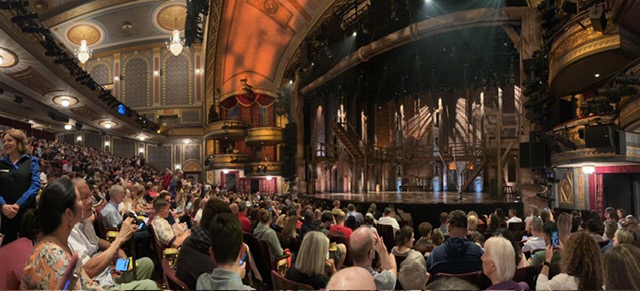WALA LANG
Even as some US cities suffer from stagnation, crime, homelessness, and wholesale shoplifting, New York City remains vibrant. On a short break the other month, some family members and I stayed a week in Manhattan. My trip is museums and while my companions were scootering in Central Park and shopping, I went museum visiting.
The Frick Collection’s home, a Gilded Age mansion on Fifth Avenue, is being renovated and its contents are in a brutalist Breuer building. In its real home, paintings, furniture, sculpture, porcelain, etc., are exhibited like furnishings of a dimly lit but opulent home. In its temporary location, paintings and objects are in rooms with bare gray cement walls, allowing visitors to focus on the works themselves. Thus it was that I really saw the Frick’s great masterpieces like Bellini’s “St. Francis” hung in solitary splendor in a small room lit from a trapezoid shaped window; Rembrandt’s “The Polish Rider” a mysterious painting lost in a crowded gallery; a Rembrandt Self-Portrait; Velasquez’ magnificent “Portrait of King Philip IV”; and Fragonard’s canvases of “The Progress of Love.”


“Hamilton” on Broadway (Photos by Irene L. Zinampan)
The European Galleries of the Metropolitan Museum of Art were closed. They were replacing skylights and improving gallery lighting. A selection of Dutch masterpieces, however, was in the place normally occupied by the Lehman Collection and where, surprise, Manila friends Petty and Daniel Johannot ran into each other. The Met has numerous Rembrandts and five Vermeers, a good chunk of the known paintings by the famous 16th century painter. Upstairs I renewed acquaintance with some favorites by Renoir, Gauguin, Van Gogh, Manet, and Monet.
We went on a fun city tour that was more like a party tour. Dozens of gawkers including us filed into the tour bus that was all glass picture window on its left side. Rather than the usual seats on both sides of a center aisle, the inside had three lengthwise rows of seats facing the window, in tiers. It was like watching a movie of Manhattan street scenes. Accompanied by a running patter from two guides, the bus moved slowly from the Times Square neighborhood to Madison Avenue, Columbus Circle, and back to Times Square, pausing at various places to watch street drama—actually performers doing monologues, acrobatics, classical ballet. As the tour came to a close, the guides started singing “New York, New York” and everybody joined in. Truly if you can make it there, you can make it anywhere.
The visit’s culinary highlights were New York branches of the famous Angelina’s of Paris that serves hot chocolate and pastry to die for. Peter Luger, a steakhouse in Brooklyn, was a scheduled destination. It’s so popular one has to make a timed reservation. The steak was indeed delicious and the chefs were accommodating enough to let me have mine well done.
Of course we could not miss the long-running musical “Hamilton” (it premiered in 2015) that is now drawing Manila crowds at the theater at Solaire. It is an incredible blend of history, hip-hop, and rap.
Alexander Hamilton was one of America’s less remembered founding fathers, up there with George Washington, Thomas Jefferson, and Benjamin Franklin. Author historian Ron Chernow wrote a lengthy and heavy-reading biography that Lin-Manuel Miranda read while on vacation. Miranda was fascinated by Hamilton’s life story and in a flash of creativity began developing what has become a musical biography told in rap and hip-hop to the music of a small and versatile ensemble. The actors have diverse backgrounds, with people of color playing the Caucasian Founding Fathers. True, Thomas Jefferson had children with a woman of color but he himself was a slave-owning white.
The musical traces the life of Alexander Hamilton, a penniless immigrant from the Caribbean who rose to prominence as one of America’s first leaders. His ambition, intellect, and tireless work ethic catapult him into the heart of the American Revolution and the early days of the United States government.
The central relationship in the musical is between Alexander Hamilton and Aaron Burr, his friend-turned-rival. The two are linked by ambition and betrayal, culminating in a duel where Burr shoots and kills Hamilton.
The musical is entirely sung and danced by incredibly talented actors. The lyrics are rapid-fire and witty. Songs are musical highlights that not only advance the plot but also provide insight into the characters’ inner thoughts.
The musical both entertain and educates. The controversies of the young nation—state versus federal powers, slavery favored by the agricultural south and opposed by the industrialized North, the location of the nation’s capital, relations with Britain, the banking and monetary system. The decisions and controversies of the young nation are touched upon by the musical, making history accessible and relatable to a modern audience.
“Hamilton” has inspired young artists, playwrights, composers, poets—and provoked conversations about history, diversity, and the American Dream. Its influence can be seen in the way it has inspired and encouraged other creators to think outside the box.
What the musical does would be comparable to the history of the Philippine Revolution and the Filipino-American War told through a musical or a balagtasan-in-rap relating the life of Brigadier General Jose Ignacio Paua, the Chinese immigrant from Fujian who became a Katipunero and later a general under Emilio Aguinaldo in the First Philippine Republic. He was in the contingent that arrested Andres Bonifacio and later became a mayor during the American Regime.
“Hamilton” is history made accessible and relevant to a new generation, reminding audiences that the US—and the Philippines too—is in many respects a story of ambition, struggle, and resilience.
Comments are cordially invited, addressed to [email protected]